Rafail Fridman
DynVFX: Augmenting Real Videos with Dynamic Content
Feb 05, 2025



Abstract:We present a method for augmenting real-world videos with newly generated dynamic content. Given an input video and a simple user-provided text instruction describing the desired content, our method synthesizes dynamic objects or complex scene effects that naturally interact with the existing scene over time. The position, appearance, and motion of the new content are seamlessly integrated into the original footage while accounting for camera motion, occlusions, and interactions with other dynamic objects in the scene, resulting in a cohesive and realistic output video. We achieve this via a zero-shot, training-free framework that harnesses a pre-trained text-to-video diffusion transformer to synthesize the new content and a pre-trained Vision Language Model to envision the augmented scene in detail. Specifically, we introduce a novel inference-based method that manipulates features within the attention mechanism, enabling accurate localization and seamless integration of the new content while preserving the integrity of the original scene. Our method is fully automated, requiring only a simple user instruction. We demonstrate its effectiveness on a wide range of edits applied to real-world videos, encompassing diverse objects and scenarios involving both camera and object motion.
Space-Time Diffusion Features for Zero-Shot Text-Driven Motion Transfer
Dec 03, 2023

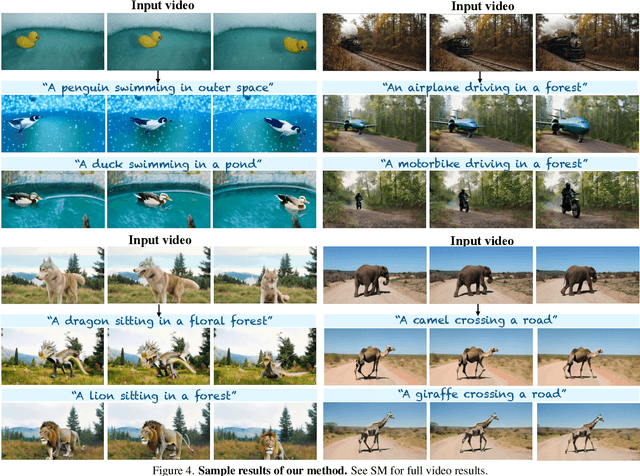
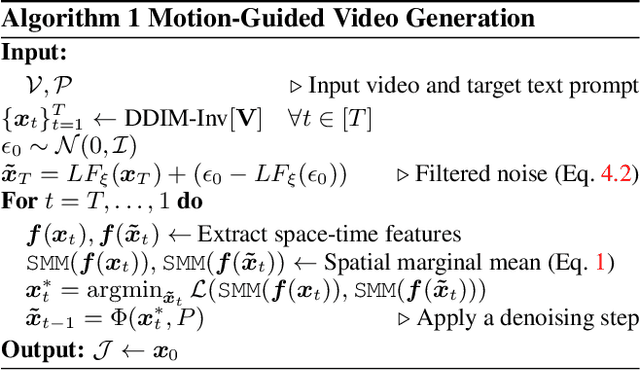
Abstract:We present a new method for text-driven motion transfer - synthesizing a video that complies with an input text prompt describing the target objects and scene while maintaining an input video's motion and scene layout. Prior methods are confined to transferring motion across two subjects within the same or closely related object categories and are applicable for limited domains (e.g., humans). In this work, we consider a significantly more challenging setting in which the target and source objects differ drastically in shape and fine-grained motion characteristics (e.g., translating a jumping dog into a dolphin). To this end, we leverage a pre-trained and fixed text-to-video diffusion model, which provides us with generative and motion priors. The pillar of our method is a new space-time feature loss derived directly from the model. This loss guides the generation process to preserve the overall motion of the input video while complying with the target object in terms of shape and fine-grained motion traits.
SceneScape: Text-Driven Consistent Scene Generation
Feb 02, 2023
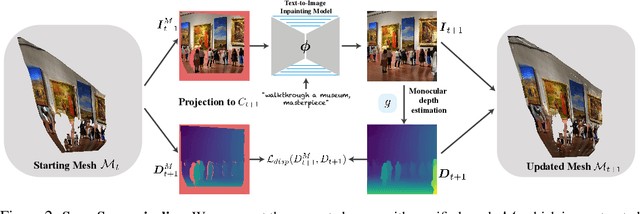

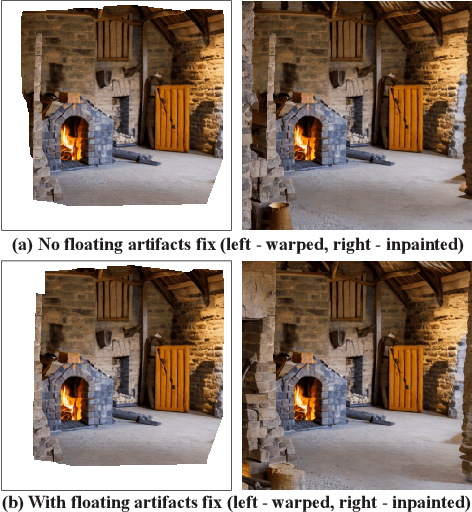
Abstract:We propose a method for text-driven perpetual view generation -- synthesizing long videos of arbitrary scenes solely from an input text describing the scene and camera poses. We introduce a novel framework that generates such videos in an online fashion by combining the generative power of a pre-trained text-to-image model with the geometric priors learned by a pre-trained monocular depth prediction model. To achieve 3D consistency, i.e., generating videos that depict geometrically-plausible scenes, we deploy an online test-time training to encourage the predicted depth map of the current frame to be geometrically consistent with the synthesized scene; the depth maps are used to construct a unified mesh representation of the scene, which is updated throughout the generation and is used for rendering. In contrast to previous works, which are applicable only for limited domains (e.g., landscapes), our framework generates diverse scenes, such as walkthroughs in spaceships, caves, or ice castles. Project page: https://scenescape.github.io/
Text2LIVE: Text-Driven Layered Image and Video Editing
Apr 05, 2022
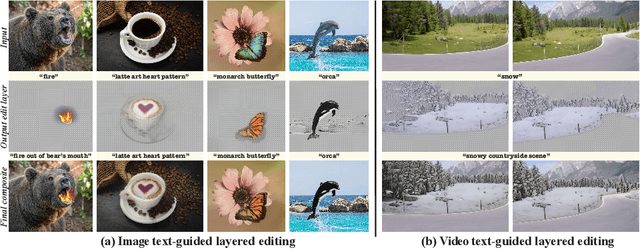


Abstract:We present a method for zero-shot, text-driven appearance manipulation in natural images and videos. Given an input image or video and a target text prompt, our goal is to edit the appearance of existing objects (e.g., object's texture) or augment the scene with visual effects (e.g., smoke, fire) in a semantically meaningful manner. We train a generator using an internal dataset of training examples, extracted from a single input (image or video and target text prompt), while leveraging an external pre-trained CLIP model to establish our losses. Rather than directly generating the edited output, our key idea is to generate an edit layer (color+opacity) that is composited over the original input. This allows us to constrain the generation process and maintain high fidelity to the original input via novel text-driven losses that are applied directly to the edit layer. Our method neither relies on a pre-trained generator nor requires user-provided edit masks. We demonstrate localized, semantic edits on high-resolution natural images and videos across a variety of objects and scenes.
 Add to Chrome
Add to Chrome Add to Firefox
Add to Firefox Add to Edge
Add to Edge